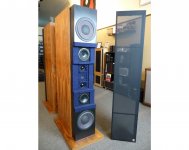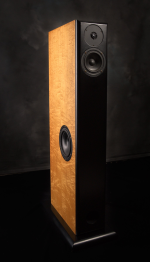Imaging can be adversely affected by reflections. Sometimes reflections can be acceptable. I believe that a larger baffle can image properly. When you say 'better' it doesn't feel right, but there are a couple of matters of interest in my opinion.
One I might be able to explain via the precedence effect, and more specifically a phenomenon called summing localisation. Here a secondary source of sound (such as diffraction) might be perceived as a part of the original source when it is delayed only a very short time from the direct sound. In this case a small cabinet frontage.
The other is that diffraction could be contributing to spaciousness. In part it may be widening the directivity in a roundabout way. Spaciousness is not the same as imaging but it is often mixed up when talking about it. Spaciousness typically refers to room engagement or other reflections.
One I might be able to explain via the precedence effect, and more specifically a phenomenon called summing localisation. Here a secondary source of sound (such as diffraction) might be perceived as a part of the original source when it is delayed only a very short time from the direct sound. In this case a small cabinet frontage.
The other is that diffraction could be contributing to spaciousness. In part it may be widening the directivity in a roundabout way. Spaciousness is not the same as imaging but it is often mixed up when talking about it. Spaciousness typically refers to room engagement or other reflections.
Thanks AllenB, you are right. Then why do small baffle immage better?
Is it real imagine, or hyper, fake imaging?
What I mean is, it's known that dips in the 2.4 kHz range cause the perception of imaging to improve, but this can be, to me, quite unnatural.
Could small baffles accentuate this effect?
From AllenB
This is precisely what I was getting at when I said that most people hear an improvement when a baffle is covered in heavy felt or foam... Assuming the mid and HF balance is maintained, most people hear an improvement... But why? As Dr. Geddes points out, sound travelling along a baffle should be unaffected by whether the baffle is hard or soft, reflective or absorbtive.
Here is a quote from Dr Geddes recently. The subject was regarding the texture of a wall for which a sound wavefront was travelling normal to
This is precisely what I was getting at when I said that most people hear an improvement when a baffle is covered in heavy felt or foam... Assuming the mid and HF balance is maintained, most people hear an improvement... But why? As Dr. Geddes points out, sound travelling along a baffle should be unaffected by whether the baffle is hard or soft, reflective or absorbtive.
Yes, Dunlavy's speakers. I never had a chance to hear them. Today, we have both Wilson and Vandersteen using thick felt or foam on the baffles, although Vandersteen seems to be limiting it to just Tweeters in their latest designs.
I don't think we can't explain, using measured data, why most people (but not all) prefer a felt/foam covered baffle. I don't think we understand enough about how our brains process sound.
Similarly, I don't think we can explain, using measured data, why most people (but once again, not all people), prefer a small narrow baffle for mid and high frequencies. B&W 800-series speakers take this approach to the logical extreme, and most people find them to sound very good. Some people are completely seduced by them... But some people don't hear anything special.
I don't think we can't explain, using measured data, why most people (but not all) prefer a felt/foam covered baffle. I don't think we understand enough about how our brains process sound.
Similarly, I don't think we can explain, using measured data, why most people (but once again, not all people), prefer a small narrow baffle for mid and high frequencies. B&W 800-series speakers take this approach to the logical extreme, and most people find them to sound very good. Some people are completely seduced by them... But some people don't hear anything special.
Last edited:
There may be a little absorption at the felt along the way. This may create diffraction, slowly and gradually, just like a roundover does. After all, the wavefront would be relying on that sound at the edge to travel well with the baffle. Eventually the edge effect may be somewhat mitigated. I have no measurements of this.an improvement when a baffle is covered in heavy felt or foam... Assuming the mid and HF balance is maintained, most people hear an improvement... But why? As Dr. Geddes points out, sound travelling along a baffle should be unaffected by whether the baffle is hard or soft, reflective or absorbtive.
For dunlavy it looks like the felt is used to minimize reflections due to the deep stepped baffle arrangement and some dispersion control. For wilsons it looks more to be used so they can use thin grilles
in floyd e. toole's book 'sound reproduction loudspeakers and room', chapter 9.1.3 'a fundamental flaw in stereo', figure 9.7, he shows the frequency response difference of a real center channel loudspeaker and the response of a stereo phantom center. it could be so that the diffraction response of a narrow baffle works as a compensation circuit for the faulty frequency response that the standard stereo loudspeaker setup gives
These graphs tell me:
The more baffle the more influence on the FR.
F G H I are not practically possible as a driver is bigger then a point. (a circle)
A is best, but the bigger the driver the wider the and more influential the baffle.
D is the best when more the 1 driver (or many small) is used and could be improved with rounded edges on top and bottom. Smaller drivers have less width and least baffle in this design and will have the best off axis response (less directional)
But what we hear is the combination of direct and indirect sound these measurements are on axis. A and D will be best by far in the horizontal off axis response as they are rounded baffles.
D with a line of small drivers will have the widest horizontal and most narrow vertical off axis response and is great to match to a line tweeter like a ribbon, AMT or planar.
A and D also hold pressure best. (most pipes and buckets are round/cilinders for that reason)
PVC pipe is great for a strong and light speakerbox.
A is best but only usable with a FR or coaxial driver, and otherwise D with rounded top and bottom. (vertically stretched A)
... and yet "K" (rectangle with the driver in a non-symmetric location) is very good, and it is also one of the easiest to build. "L" is even better than "K"... since we most always use a thick baffle anyway, the beveled edges of "L" are not too difficult with a decent table saw.
I believe that there is something going on with narrow baffles, something that is beyond the diffraction effects.
I believe that there is something going on with narrow baffles, something that is beyond the diffraction effects.
IMO asymetric placement is a bad practice as it fixes the on axis response but destroys off axis response. On and off axis response should be similar.
D and L (with a minimal flat baffle to mount the drivers) will be similar on axis, but D will have better horizontal off axis response.
D and L (with a minimal flat baffle to mount the drivers) will be similar on axis, but D will have better horizontal off axis response.
Agreed, I intuitively don't like the idea of smoothing the response by varying the diffractions. J is very good.
B Seems to be a Hemisphere; half sphere. Looks a bit weird in the other pic.
I guess this is original source.

I guess this is original source.

Last edited:
" Hey Audiophiles! | DO SPEAKERS REALLY DISAPPEAR?!
Ron from New Record Day made the claim that the baffle has something to do with a speakers ability to disappear! Was he full of it? Well, in this Tech Talk, Danny Richie of GR-Research walks us through some of the technical aspects that might help us better understand whether Ron is full of it, or possibly onto something!"
YouTube
Ron from New Record Day made the claim that the baffle has something to do with a speakers ability to disappear! Was he full of it? Well, in this Tech Talk, Danny Richie of GR-Research walks us through some of the technical aspects that might help us better understand whether Ron is full of it, or possibly onto something!"
YouTube
IMO asymetric placement is a bad practice as it fixes the on axis response but destroys off axis response. On and off axis response should be similar.
i do not follow, diffraction offaxis will still not be the same as onaxis regardless of any offset or not, since there will be time differencies / path length differencies to baffle edges anyway offaxis?
You are right scottjoplin; by placing the tweeter asymetrical on the baffle, the off axis response left and right are no longer symetrical and impossible to match both to the on axis response.
- Home
- Loudspeakers
- Multi-Way
- Benefits of minimal baffle

